RENAULT WIND 2012 1.G Owner's Manual
Manufacturer: RENAULT, Model Year: 2012, Model line: WIND, Model: RENAULT WIND 2012 1.GPages: 185, PDF Size: 5.52 MB
Page 21 of 185

seat belts .............................................. (up to the end of the DU)
additional methods of restraint ............. (up to the end of the DU)
seat belt pretensioners ......................... (up to the end of the DU)
air bag ................................................... (up to the end of the DU)
air bag ................................................... (up to the end of the DU)
methods of restraint in addition to the front seat belts
(up to the end of the DU)
additional methods of restraint to the front seat belts ......................(up to the end of the DU)
methods of restraint in addition to the seat belts
(up to the end of the DU)
pretensioners ......................................................... (current page)
1.15
ENG_UD20473_2
Dispositifs complémentaires aux ceintures avant (E33 - X33 - Renault)
ENG_NU_865-6_E33_Renault_1
Additional methods of restraint:
to the front seat belts
METHODS OF RESTRAINT IN ADDITION TO THE FRONT SEAT BELTS (1/3)
Depending on the vehicle, they are
composed of:
– seat belt pretensioners;
– chest-level load limiters;
– air bags for driver and front pas -
senger.
These systems are designed to act in-
dependently or together when the ve -
hicle is subjected to a frontal impact.
Depending on the severity of the
impact, the system can trigger:
– seat belt locking;
– the seat belt inertia reel pretensioner
(which engages to correct seat belt
slack);
– the front air bags.
Load limiterAbove a certain severity of impact, this
mechanism is used to limit the force of
the belt against the body so that it is at
an acceptable level.
pretensioners
The pretensioners hold the seat belt
against the body, holding the occupant
more securely against the seat, thus in-
creasing the seat belt’s efficiency.
With the ignition on, if the vehicle is
subject to a significant frontal impact
the system may, depending on the se-
verity of the impact, trigger inertia reel
pretensioner 1 on the front seats.
– Have the entire restraint
system checked following
an accident.
– No operation whatso -
ever is permitted on any part of
the system (pretensioners, air
bags, computers, wiring) and the
system components must not
be reused on any other vehicle,
even if identical.
– To avoid incorrect triggering of
the system which may cause
injury, only qualified personnel
from an approved dealer may
work on the pretensioner and air
bag system.
– The electric trigger system may
only be tested by a specially
trained technician using special
equipment.
– When the vehicle is scrapped,
contact an approved dealer for
disposal of the pretensioner and
air bag gas generators.
1
Page 22 of 185

1.16
ENG_UD20473_2
Dispositifs complémentaires aux ceintures avant (E33 - X33 - Renault)
ENG_NU_865-6_E33_Renault_1
Jaune NoirNoir texte
METHODS OF RESTRAINT IN ADDITION TO THE FRONT SEAT BELTS (2/3)
Operation
This system is only operational when
the ignition is switched on.
In a severe frontal impact, the air bags
inflate rapidly, cushioning the impact
of the driver’s head and chest against
the steering wheel and of the front pas-
senger against the dashboard. The air
bags then deflate immediately so that
the passengers are not in any way hin-
dered when leaving the vehicle.
A
Air bags for driver and front
passenger
Fitted to the driver and passenger side.
Depending on the vehicle, the pres -
ence of this equipment is indicated by
the word “air bag” on the steering wheel
and dashboard (air bag zone A ) and
a symbol on the lower section of the
windscreen.
Each air bag system consists of:
– an air bag and gas generator fitted
on the steering wheel for the driver
and in the dashboard for the front
passenger;
– a shared computer, which includes
the impact detector and the moni -
tor controlling the electrical trigger
system for each of the gas genera -
tors;
– a single indicator light
å on the
instrument panel;
– remote sensors.
The air bag system uses
pyrotechnic principles. This
explains why, when the air
bag inflates, it will gener -
ate heat, produce smoke (this does
not mean that a fire is about to start)
and make a noise upon detonation.
In a situation where an air bag is
required, it will inflate immediately
and this may cause some minor, su-
perficial grazing to the skin or other
problems.
Page 23 of 185
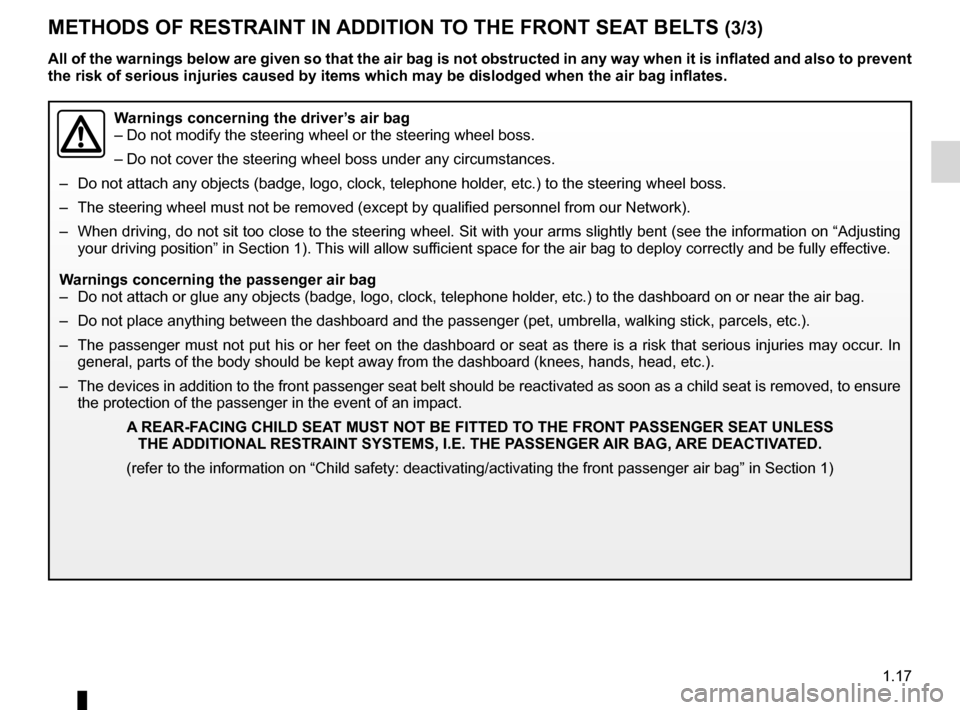
JauneNoirNoir texte
1.17
ENG_UD20473_2
Dispositifs complémentaires aux ceintures avant (E33 - X33 - Renault)
ENG_NU_865-6_E33_Renault_1
METHODS OF RESTRAINT IN ADDITION TO THE FRONT SEAT BELTS (3/3)
Warnings concerning the driver’s air bag
– Do not modify the steering wheel or the steering wheel boss.
– Do not cover the steering wheel boss under any circumstances.
– Do not attach any objects (badge, logo, clock, telephone holder, etc.) to the steering wheel boss.
– The steering wheel must not be removed (except by qualified personnel from our Network).
– When driving, do not sit too close to the steering wheel. Sit with your arms slightly bent (see the information on “Adjusting
your driving position” in Section 1). This will allow sufficient space for the air bag to deploy correctly and be fully effective.
Warnings concerning the passenger air bag
– Do not attach or glue any objects (badge, logo, clock, telephone holder, etc.) to the dashboard on or near the air bag.
– Do not place anything between the dashboard and the passenger (pet, umbrella, walking stick, parcels, etc.).
– The passenger must not put his or her feet on the dashboard or seat as there is a risk that serious injuries may occur. In
general, parts of the body should be kept away from the dashboard (knees, hands, head, etc.).
– The devices in addition to the front passenger seat belt should be reactivated as soon as a child seat is removed, to ensure
the protection of the passenger in the event of an impact.
A REAR-FACING CHILD SEAT MUST NOT BE FITTED TO THE FRONT p ASSENGER SEAT UNLESS
THE ADDITIONAL RESTRAINT SYSTEMS, I.E. THE p ASSENGER AIR BAG, ARE DEACTIVATED.
(refer to the information on “Child safety: deactivating/activating the front passenger air bag” in Section 1)
All of the warnings below are given so that the air bag is not obstructed in any way when it is inflated and also to prevent
the risk of serious injuries caused by items which may be dislodged when the air bag inflates.
Page 24 of 185

air bag................................................... (up to the end of the DU)
additional methods of restraint side protection ................................ (up to the end of the DU)
methods of restraint in addition to the seat belts
(up to the end of the DU)
seat belts .............................................. (up to the end of the DU)
air bag ................................................... (up to the end of the DU)
side protection devices ......................... (up to the end of the DU)
1.18
ENG_UD11161_1
Dispositifs de protection latérale (E33 - X33 - Renault)
ENG_NU_865-6_E33_Renault_1
side protection
SIDE pROTECTION DEVICES
Warnings concerning the side air bag
– Fitting seat covers: seats equipped with an air bag require covers
specifically designed for your vehicle. Contact an approved Dealer to find
out if these covers are available. The use of any covers other than those
designed for your vehicle (and including those designed for another vehicle)
may affect the operation of the air bags and reduce your protection.
– Do not place any accessories, objects or even pets between the seatback, the
door and the internal fittings. Do not cover the seatback with any items such as
clothes or accessories. This may prevent the air bag from operating correctly
or cause injury when the air bag is deployed.
– No work or modification whatsoever may be carried out on the seat or internal
fittings, except by qualified personnel from an approved dealer.
Side air bags
These air bags are fitted to the front
seats and are activated at the sides of
the seats (door side) to protect the oc-
cupants in the event of a severe side
impact.
Depending on the vehicle, a mark -
ing on the windscreen informs you
of the presence of additional means
of restraint (air bags, pretensioners,
etc.) in the passenger compartment.
These air bags operate
through slits in the front
s e a t b a c k s ( d o o r s i d e ) :
never insert any objects in
these slits.
Page 25 of 185

air bag................................................... (up to the end of the DU)
methods of restraint in addition to the seat belts
(up to the end of the DU)
additional methods of restraint ............. (up to the end of the DU)
seat belts .............................................. (up to the end of the DU)
air bag ................................................... (up to the end of the DU)
1.19
ENG_UD11162_1
Dispositifs de retenue complémentaire (E33 - X33 - Renault)
ENG_NU_865-6_E33_Renault_1
All of the warnings below are given so that the air bag is not obstructed in any
way when it is inflated and also to prevent the risk of serious injuries caused
by items which may be dislodged when the air bag inflates.
The air bag is designed to complement the action of the seat belt. Both
the air bags and seat belts are integral parts of the same protection
system. It is therefore essential to wear seat belts at all times. If seat belts
are not worn, the occupants are exposed to the risk of serious injury in
the event of an accident. It may also increase the risk of minor superficial injuries
occurring when the air bag is deployed, although such minor injuries are always
possible with air bags.
If the vehicle should overturn or suffer a rear impact, however severe, the pre-
tensioners and air bags are not always triggered. Shocks to the underbody of the
vehicle, e.g. from pavements, potholes or stones, can all trigger these systems.
– No work or modification whatsoever may be carried out on any part of the air
bag system (air bags, pretensioners, computer, wiring harness, etc.), except
by qualified personnel from an approved dealer.
– To ensure that the system is in good working order and to avoid accidental trig-
gering of the system which may cause injury, only qualified Network personnel
may work on the air bag system.
– As a safety precaution, have the air bag system checked if your vehicle has
been involved in an accident, or is stolen or broken into.
– When selling or lending the vehicle, inform the user of these points and hand
over this driver’s handbook with the vehicle.
– When scrapping your vehicle, contact your approved dealer for disposal of the
gas generator(s).
Operating faults
Warning light 1 å will light up on
the instrument panel when the ignition
is turned on and then go out after a few
seconds.
If it does not light up when the ignition
is switched on, or lights up while the
engine is running, there is a fault in the
system (air bags, pretensioners etc.).
Contact your approved dealer as soon
as possible. Your protection will be re-
duced until this fault is rectified.
ADDITIONAL METHODS OF RESTRAINT
1
Page 26 of 185
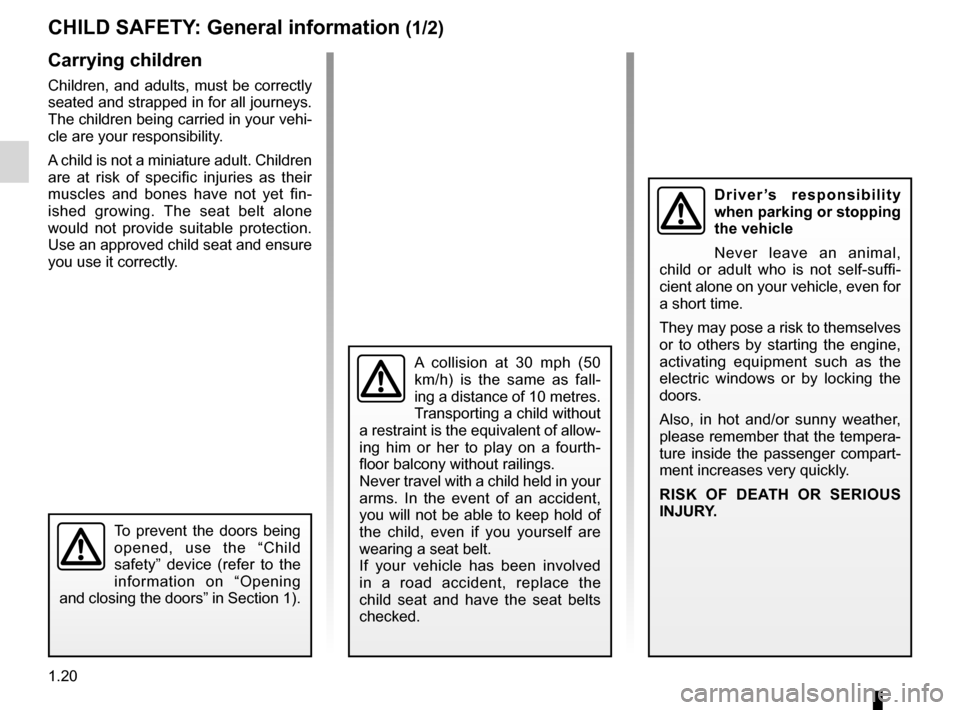
child safety............................................ (up to the end of the DU)
child restraint/seat ................................ (up to the end of the DU)
child restraint/seat ................................ (up to the end of the DU)
child restraint/seat ................................ (up to the end of the DU)
child seats ............................................. (up to the end of the DU)
transporting children ............................. (up to the end of the DU)
children ................................................. (up to the end of the DU)
1.20
ENG_UD20549_2
Sécurité enfants : généralités (E33 - X33 - Renault)
ENG_NU_865-6_E33_Renault_1
Jaune NoirNoir texte
Child safety: General information
CHILD SAFETY : General information (1/2)
Carrying children
Children, and adults, must be correctly
seated and strapped in for all journeys.
The children being carried in your vehi-
cle are your responsibility.
A child is not a miniature adult. Children
are at risk of specific injuries as their
muscles and bones have not yet fin -
ished growing. The seat belt alone
would not provide suitable protection.
Use an approved child seat and ensure
you use it correctly.
A collision at 30 mph (50
km/h) is the same as fall -
ing a distance of 10 metres.
Transporting a child without
a restraint is the equivalent of allow-
ing him or her to play on a fourth -
floor balcony without railings.
Never travel with a child held in your
arms. In the event of an accident,
you will not be able to keep hold of
the child, even if you yourself are
wearing a seat belt.
If your vehicle has been involved
in a road accident, replace the
child seat and have the seat belts
checked.
D r i v e r ’s r e s p o n s i b i l i t y
when parking or stopping
the vehicle
Never leave an animal,
child or adult who is not self-suffi -
cient alone on your vehicle, even for
a short time.
They may pose a risk to themselves
or to others by starting the engine,
activating equipment such as the
electric windows or by locking the
doors.
Also, in hot and/or sunny weather,
please remember that the tempera-
ture inside the passenger compart-
ment increases very quickly.
RISK OF DEATH OR SERIOUS
INJURY.
To prevent the doors being
opened, use the “Child
safety” device (refer to the
information on “Opening
and closing the doors” in Section 1).
Page 27 of 185
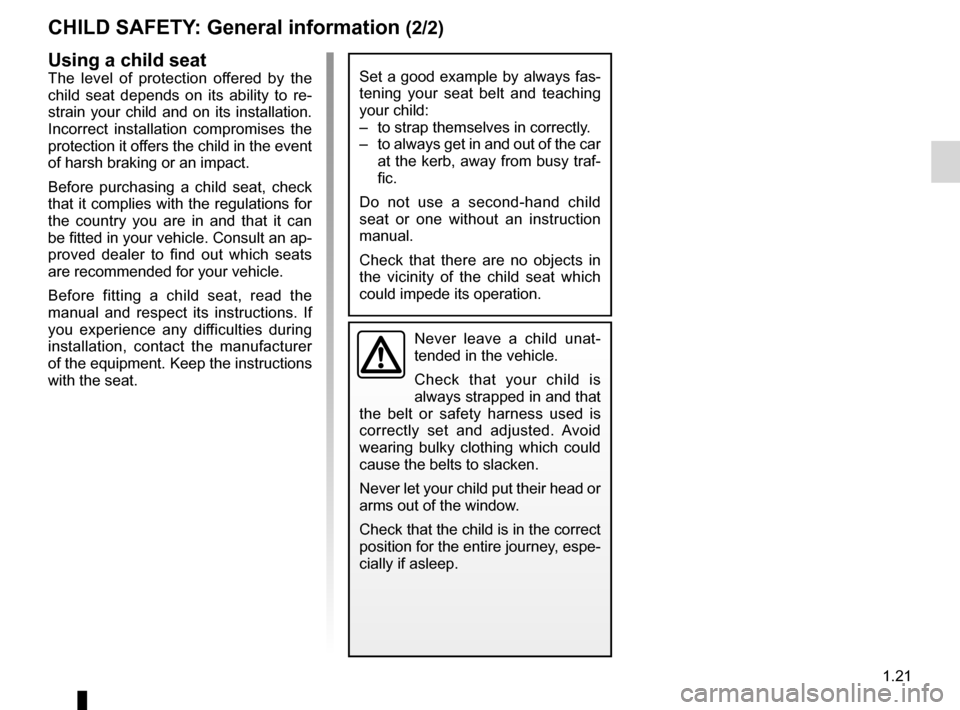
towing rings .......................................... (up to the end of the DU)
JauneNoirNoir texte
1.21
ENG_UD20549_2
Sécurité enfants : généralités (E33 - X33 - Renault)
ENG_NU_865-6_E33_Renault_1
CHILD SAFETY : General information (2/2)
Using a child seatThe level of protection offered by the
child seat depends on its ability to re -
strain your child and on its installation.
Incorrect installation compromises the
protection it offers the child in the event
of harsh braking or an impact.
Before purchasing a child seat, check
that it complies with the regulations for
the country you are in and that it can
be fitted in your vehicle. Consult an ap-
proved dealer to find out which seats
are recommended for your vehicle.
Before fitting a child seat, read the
manual and respect its instructions. If
you experience any difficulties during
installation, contact the manufacturer
of the equipment. Keep the instructions
with the seat.Set a good example by always fas-
tening your seat belt and teaching
your child:
– to strap themselves in correctly.
– to always get in and out of the car
at the kerb, away from busy traf-
fic.
Do not use a second-hand child
seat or one without an instruction
manual.
Check that there are no objects in
the vicinity of the child seat which
could impede its operation.
Never leave a child unat -
tended in the vehicle.
Check that your child is
always strapped in and that
the belt or safety harness used is
correctly set and adjusted. Avoid
wearing bulky clothing which could
cause the belts to slacken.
Never let your child put their head or
arms out of the window.
Check that the child is in the correct
position for the entire journey, espe-
cially if asleep.
Page 28 of 185
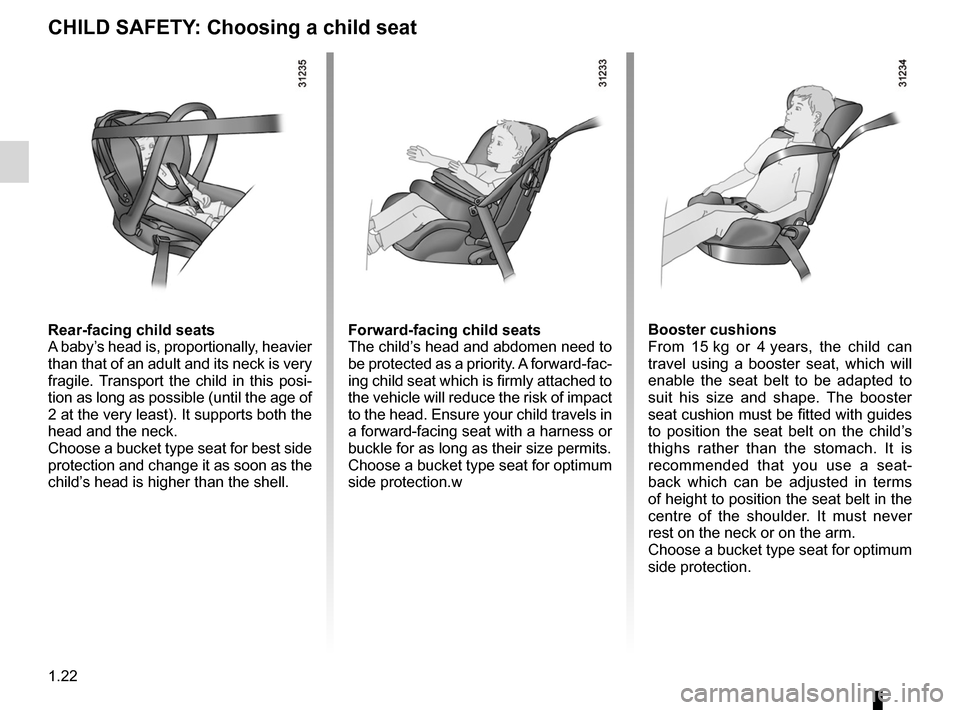
1.22
ENG_UD18759_2
Sécurité enfants : choix du siège enfant (X35 - L35 - X45 - H45 - X77 - X91 - X83 - X61 - X77 ph2 - X95 - L38 - X38 - X62 - Renault)
ENG_NU_865-6_E33_Renault_1
CHILD SAFETY : Choosing a child seat
Rear-facing child seats
A baby’s head is, proportionally, heavier
than that of an adult and its neck is very
fragile. Transport the child in this posi-
tion as long as possible (until the age of
2 at the very least). It supports both the
head and the neck.
Choose a bucket type seat for best side
protection and change it as soon as the
child’s head is higher than the shell.Forward-facing child seats
The child’s head and abdomen need to
be protected as a priority. A forward-fac-
ing child seat which is firmly attached to
the vehicle will reduce the risk of impact
to the head. Ensure your child travels in
a forward-facing seat with a harness or
buckle for as long as their size permits.
Choose a bucket type seat for optimum
side protection.w Booster cushions
From 15
kg or 4 years, the child can
travel using a booster seat, which will
enable the seat belt to be adapted to
suit his size and shape. The booster
seat cushion must be fitted with guides
to position the seat belt on the child’s
thighs rather than the stomach. It is
recommended that you use a seat -
back which can be adjusted in terms
of height to position the seat belt in the
centre of the shoulder. It must never
rest on the neck or on the arm.
Choose a bucket type seat for optimum
side protection.
Page 29 of 185
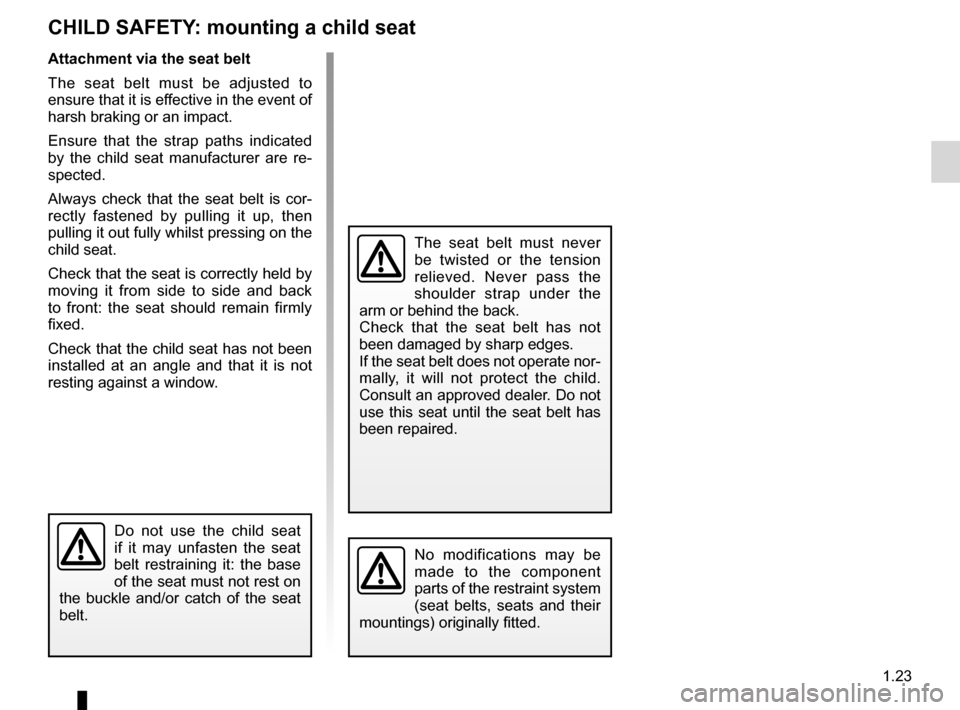
child restraint/seat ................................ (up to the end of the DU)
child restraint/seat ................................ (up to the end of the DU)
child restraint/seat ................................ (up to the end of the DU)
child safety ............................................ (up to the end of the DU)
child seats ............................................. (up to the end of the DU)
transporting children ............................. (up to the end of the DU)
towing rings .......................................... (up to the end of the DU)
1.23
ENG_UD11164_1
Sécurité enfants : choix de la fixation du siège enfant (E33 - X33 - Renault)
ENG_NU_865-6_E33_Renault_1
choosing a child seat mounting
CHILD SAFETY : mounting a child seat
Attachment via the seat belt
The seat belt must be adjusted to
ensure that it is effective in the event of
harsh braking or an impact.
Ensure that the strap paths indicated
by the child seat manufacturer are re -
spected.
Always check that the seat belt is cor-
rectly fastened by pulling it up, then
pulling it out fully whilst pressing on the
child seat.
Check that the seat is correctly held by
moving it from side to side and back
to front: the seat should remain firmly
fixed.
Check that the child seat has not been
installed at an angle and that it is not
resting against a window.
No modifications may be
made to the component
parts of the restraint system
(seat belts, seats and their
mountings) originally fitted.
The seat belt must never
be twisted or the tension
relieved. Never pass the
shoulder strap under the
arm or behind the back.
Check that the seat belt has not
been damaged by sharp edges.
If the seat belt does not operate nor-
mally, it will not protect the child.
Consult an approved dealer. Do not
use this seat until the seat belt has
been repaired.
Do not use the child seat
if it may unfasten the seat
belt restraining it: the base
of the seat must not rest on
the buckle and/or catch of the seat
belt.
Page 30 of 185
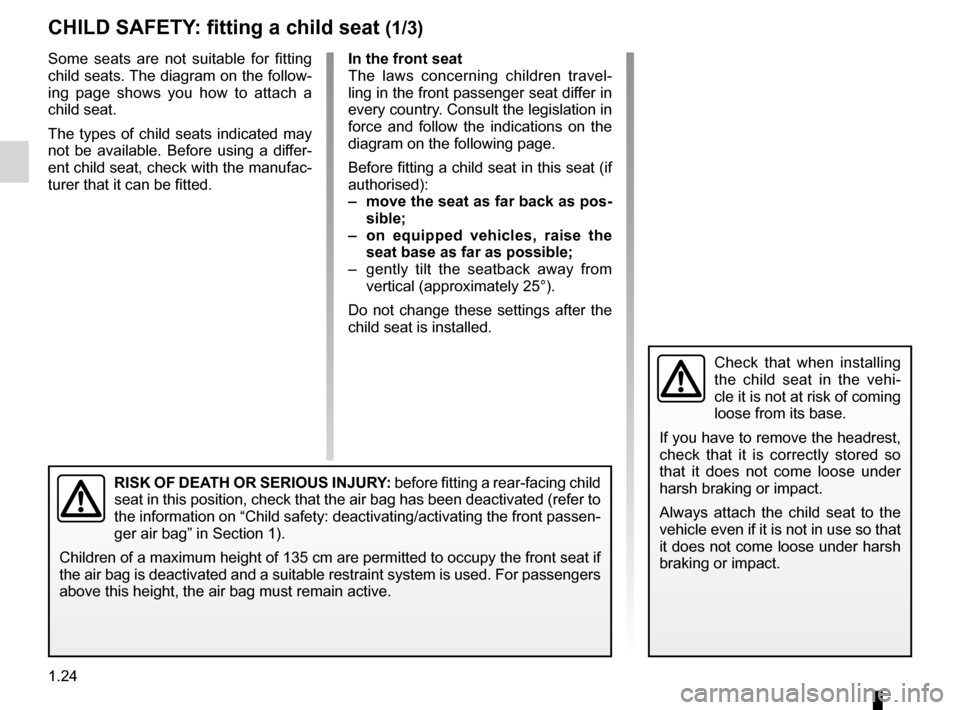
child restraint/seat ................................ (up to the end of the DU)
child restraint/seat ................................ (up to the end of the DU)
child restraint/seat ................................ (up to the end of the DU)
child safety ............................................ (up to the end of the DU)
child seats ............................................. (up to the end of the DU)
transporting children ............................. (up to the end of the DU)
1.24
ENG_UD20474_3
Sécurité enfants : installation du siège enfant (E33 - X33 - Renault)
ENG_NU_865-6_E33_Renault_1
Jaune NoirNoir texte
Some seats are not suitable for fitting
child seats. The diagram on the follow -
ing page shows you how to attach a
child seat.
The types of child seats indicated may
not be available. Before using a differ-
ent child seat, check with the manufac-
turer that it can be fitted.
fitting a child seat
CHILD SAFETY : fitting a child seat (1/3)
In the front seat
The laws concerning children travel -
ling in the front passenger seat differ in
every country. Consult the legislation in
force and follow the indications on the
diagram on the following page.
Before fitting a child seat in this seat (if
authorised):
– move the seat as far back as pos-
sible;
– on equipped vehicles, raise the
seat base as far as possible;
– gently tilt the seatback away from
vertical (approximately 25°).
Do not change these settings after the
child seat is installed.
Check that when installing
the child seat in the vehi -
cle it is not at risk of coming
loose from its base.
If you have to remove the headrest,
check that it is correctly stored so
that it does not come loose under
harsh braking or impact.
Always attach the child seat to the
vehicle even if it is not in use so that
it does not come loose under harsh
braking or impact.
RISK OF DEATH OR SERIOUS INJURY: before fitting a rear-facing child
seat in this position, check that the air bag has been deactivated (refer to
the information on “Child safety: deactivating/activating the front passen-
ger air bag” in Section 1).
Children of a maximum height of 135 cm are permitted to occupy the front seat if
the air bag is deactivated and a suitable restraint system is used. For passengers
above this height, the air bag must remain active.